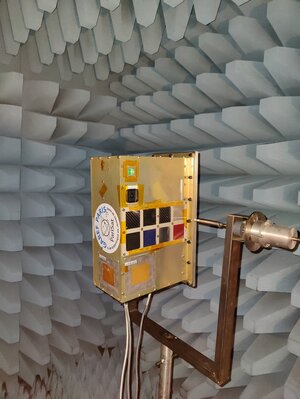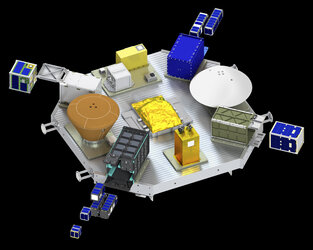Accept all cookies Accept only essential cookies See our Cookie Notice

About ESA
The European Space Agency (ESA) is Europe’s gateway to space. Its mission is to shape the development of Europe’s space capability and ensure that investment in space continues to deliver benefits to the citizens of Europe and the world.
Highlights
ESA - United space in Europe
This is ESA ESA facts Member States & Cooperating States Funding Director General Top management For Member State Delegations European vision European Space Policy ESA & EU Space Councils Responsibility & Sustainability Annual Report Calendar of meetings Corporate newsEstablishments & sites
ESA Headquarters ESA ESTEC ESA ESOC ESA ESRIN ESA EAC ESA ESAC Europe's Spaceport ESA ESEC ESA ECSAT Brussels Office Washington OfficeWorking with ESA
Business with ESA ESA Commercialisation Gateway Law at ESA Careers Cyber resilience at ESA IT at ESA Newsroom Partnerships Merchandising Licence Education Open Space Innovation Platform Integrity and Reporting Administrative Tribunal Health and SafetyMore about ESA
History ESA Historical Archives Exhibitions Publications Art & Culture ESA Merchandise Kids Diversity ESA Brand Centre ESA ChampionsLatest
Space in Member States
Find out more about space activities in our 23 Member States, and understand how ESA works together with their national agencies, institutions and organisations.
Science & Exploration
Exploring our Solar System and unlocking the secrets of the Universe
Go to topicAstronauts
Missions
Juice Euclid Webb Solar Orbiter BepiColombo Gaia ExoMars Cheops Exoplanet missions More missionsActivities
International Space Station Orion service module Gateway Concordia Caves & Pangaea BenefitsLatest
Space Safety
Protecting life and infrastructure on Earth and in orbit
Go to topicAsteroids
Asteroids and Planetary Defence Asteroid danger explained Flyeye telescope: asteroid detection Hera mission: asteroid deflection Near-Earth Object Coordination CentreSpace junk
About space debris Space debris by the numbers Space Environment Report In space refuelling, refurbishing and removingSafety from space
Clean Space ecodesign Zero Debris Technologies Space for Earth Supporting Sustainable DevelopmentLatest
Applications
Using space to benefit citizens and meet future challenges on Earth
Go to topicObserving the Earth
Observing the Earth Future EO Copernicus Meteorology Space for our climate Satellite missionsCommercialisation
ESA Commercialisation Gateway Open Space Innovation Platform Business Incubation ESA Space SolutionsLatest
Enabling & Support
Making space accessible and developing the technologies for the future
Go to topicBuilding missions
Space Engineering and Technology Test centre Laboratories Concurrent Design Facility Preparing for the future Shaping the Future Discovery and Preparation Advanced Concepts TeamSpace transportation
Space Transportation Ariane Vega Space Rider Future space transportation Boost! Europe's Spaceport Launches from Europe's Spaceport from 2012Latest

GAREF AEROSPATIAL club members at Kiruna station
Thank you for liking
You have already liked this page, you can only like it once!
GAREF AEROSPATIAL club members observing a satellite dish in Kiruna, Sweden.
Based in a single-story building near the Georges Carpentier stadium in Paris’s 13th district, France, the amateur space club GAREF AEROSPATIAL gather regularly after school to talk, work and be inspired by space – and design satellites. Aged between 15 and 25 years old these young adults have built the PariSat experiment flying on Ariane 6 on their own, during their free time.
The goal of PariSat’s project is simple: what materials work best to get rid of heat in space? But for this project flying on Europe’s new rocket Ariane 6, finding the answer is less important than the journey itself.
Eight square plates just 4 cm wide are being tested to see how they function as space radiators. The plates were chosen to test a wide variety of properties such as the material itself, its colour, and how they react to being heated and cooled as they fly through space on the Ariane 6 upper stage for just under three hours. A temperature sensor attached to each plate will have its data beamed back to ground control to analyse to provide real-life readings of “black-body radiation”.
The experiment is allowing the club to test and verify the Stefan-Boltzmann law of thermal radiation that was discovered in 1884 and models how an object absorbs and radiates heat.
The data that PariSat will beam to Earth will be received by Swedish Space Corporation's telemetry Kiruna station in Sweden.
-
CREDIT
GAREF AEROSPATIAL -
LICENCE
ESA Standard Licence

Ariane 6 science-after-school experiment sends back…

Black body experiment on Ariane 6 captures Pale Blue Dot

PariSat during electromagnetic testing

Ariane 6 first passengers – with names















 Germany
Germany
 Austria
Austria
 Belgium
Belgium
 Denmark
Denmark
 Spain
Spain
 Estonia
Estonia
 Finland
Finland
 France
France
 Greece
Greece
 Hungary
Hungary
 Ireland
Ireland
 Italy
Italy
 Luxembourg
Luxembourg
 Norway
Norway
 The Netherlands
The Netherlands
 Poland
Poland
 Portugal
Portugal
 Czechia
Czechia
 Romania
Romania
 United Kingdom
United Kingdom
 Slovenia
Slovenia
 Sweden
Sweden
 Switzerland
Switzerland

























